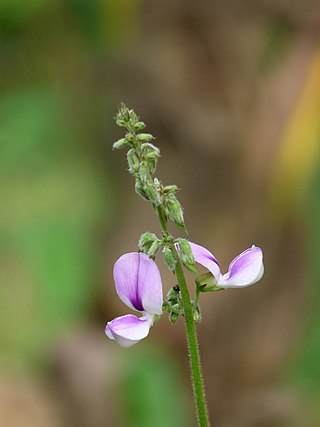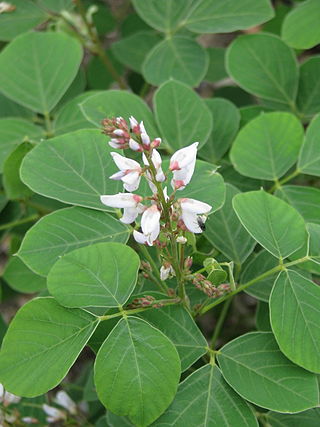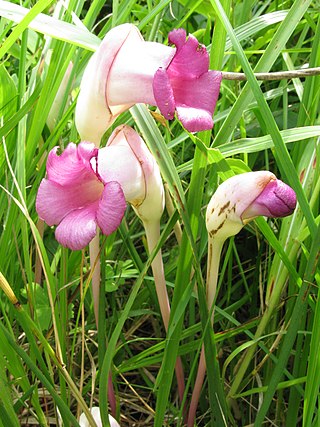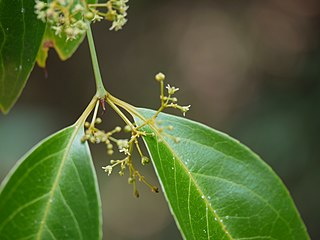
Pueraria is a genus of 15–20 species of legumes native to south, east, and southeast Asia and to New Guinea and northern Australia. The best known member is kudzu, also called Japanese arrowroot. The genus is named after 19th century Swiss botanist Marc Nicolas Puerari.

Antidesma is a genus of tropical plant in the family Phyllanthaceae formally described by Linnaeus in 1753. It is native to tropical Africa, S + E + SE Asia, Australia, and various oceanic islands. The greatest diversity occurs in Southeast Asia.

Daphniphyllum is the sole genus in the flowering plant family Daphniphyllaceae and was described as a genus in 1826. The genus includes evergreen shrubs and trees mainly native to east and southeast Asia, but also found in the Indian Subcontinent and New Guinea.

Sir David Prain was a Scottish botanist who worked in India at the Calcutta Botanical Garden and went on to become Director of the Royal Botanic Gardens, Kew.

The genus Helwingia consists of shrubs or rarely small trees native to eastern Asia, the Himalayas, and northern Indochina. It is the only genus in the family Helwingiaceae.
Leslie Pedley was an Australian botanist who specialised in the genus Acacia. He is notable for bringing into use the generic name Racosperma, creating a split in the genus, which required some 900 Australian species to be renamed, because the type species of Acacia, Acacia nilotica, now Vachellia nilotica, had a different lineage from the Australian wattles. However, the International Botanical Congress (IBC), held in Melbourne in 2011, ratified its earlier decision to retain the name Acacia for the Australian species, but to rename the African species.

Bernard Verdcourt was a biologist and taxonomist, most widely known as a botanist and latterly an honorary research fellow at the Royal Botanic Gardens, Kew in London. Prior to coming to Kew in 1964, he was associated with the East African Herbarium for 15 years. Although his best-known work probably consists of his many studies of the East African flora, he has also made extensive contributions relating to African terrestrial mollusks and to entomology. Dr. Verdcourt received the Linnean Medal for botany from the Linnean Society of London in 2000. His list of publications includes more than 1,000 scientific works. The standard author abbreviation Verdc. is used to indicate this person as the author when citing a botanical name.

Pourthiaea is a genus of plants in the rose family (Rosaceae).

Pseudoraphis is a genus of Asian and Australian plants in the grass family, commonly known as mudgrasses.
Hiroyoshi Ohashi is a botanist formerly at the University of Tokyo and Tohoku University. He began publishing on Japanese Arisaema in the early 1960s. He published a couple of miscellaneous notes on Arisaema in 1963 and 1964 and these were followed by a revision of the genus for Japan jointly published in 1980 with J. Murata, and by the Araceae treatment for the Wildflowers of Japan.

Ototropis elegans is a shrub in the pea family (Fabaceae) native to Asia from Afghanistan to north-central China. Infraspecific taxa include:

Aeginetia is a genus of plants in the broomrape family Orobanchaceae, native mostly to tropical Asia and also Cameroon.

Ototropis is a genus of flowering plants in the family Fabaceae, found from Afghanistan, the Indian Subcontinent through to southern China including Taiwan, Southeast Asia, Indonesia and on to New Guinea, and introduced to Japan. There has been some nomenclatural confusion regarding this taxon over the centuries.

Grona is a genus in the flowering plant family Fabaceae. Its native range is worldwide tropics and subtropics.
Verdesmum is a monotypic genus of flowering plants belonging to the family Fabaceae. It only contains one known species, Verdesmum hentyi. It is also within the tribe Desmodieae, with another species Verdesmum menglaense but this was transferred to the Hylodesmum genus in 2019.

Reissantia is a genus of flowering plants belonging to the family Celastraceae.
Pullenia gunnii is a species of flowering plant in the legume family, Fabaceae. It is the sole species in genus Pullenia.
Maasia is a genus of flowering plants belonging to the family Annonaceae.
Sohmaea is a genus of flowering plants belonging to the family Fabaceae.
Sunhangia is a genus of flowering plants in the pea family (Fabaceae). It includes six species, which range from Afghanistan through Pakistan, India, Tibet, Myanmar, and south-central and north-central China. The species in the genus were formerly classed in genus Desmodium.












